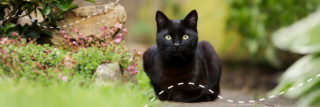
SUMMARY
- Senior cats often suffer from high blood pressure
- Regular monitoring of blood pressure helps to prolong life
- High blood pressure is an important mortality factor in CKD – there is often a connection between the two diseases
*Advertisement, as brand name mentioned
A total of nearly 350,000 older cats from 244 different practices in the UK were tested for blood pressure and it was found that high blood pressure is common in senior cats. The aim of the study was to find out more about the issue of high blood pressure in older cats and how it can be influenced to improve survival. It was shown in the study that improved monitoring of cats with hypertensionHigh blood pressure. contributes to prolonging life. Cats that were routinely screened and diagnosed for hypertension in advance of an upcoming disease had a better chance of survival than cats that already showed clinical signs of hypertension. Cats that had been treated with Amlodipine (a so-called peripheral calcium channel blocker) and had their dose adjusted also showed a better survival rate.
HIGH BLOOD PRESSURE CAN LEAD TO BLINDNESS
High blood pressure has many harmful effects on the cat and is considered an important mortality factor, especially in the context of chronic kidney disease. At the veterinary congress in Leipzig it was reported in this context that when monitoring blood pressure patients, especially the kidney values of the cat should be monitored, as high blood pressure and chronic kidney disease are often interrelated.
In addition, high blood pressure can cause the retinaThe layer of nerve cells lining the back wall inside the eye.... to detach, causing cats to lose their vision and become blind. Early initiation of hypertension therapy can not only preserve the vision of cats, but also improve it in cases of existing retinal detachment, as shown in a new study by Young et al (2019).
Click here for everything about blood pressure measurement in cats.
blood glucose masks early CKD detection
For the early detection of chronic renal failureLoss of kidney function, which may be sudden (acute) or gradual (chronic), as in chronic kidney disease. Loss of kidney function leads to a reduced filtration capacity (glomerular filtration rate) and, thus, an inability to sufficiently filter out urinary substances such as uraemic toxins. Renal..., the so-called SDMASDMA = Symmetrical Dimethylarginine, which is a degradation product of the amino acid arginine and is excreted solely through the kidneys. SDMA is a highly specific biomarker for kidney function in cats. Read more: SDMA test (blood test)... test is often performed. Symmetrical dimethylarginine (SDMA) occurs more frequently as a marker in the blood of cats with a filtration disorder (as part of CKD), so that it is not excreted in full and can accumulate in the blood. However, it is problematic that the SDMA level is lower in diabetic cats. This has been discovered by a Copenhagen research group. Diabetes mellitus can also be related to chronic kidney disease, which is why the SDMA values are difficult to interpret and may give a false negative result regarding the presence of CKD. Early detection of CKD in diabetic cats with the help of SDMA-testing may therefore be more difficult. Diabetes mellitus in cats may in turn contribute to heart disease, which increases the risk of high blood pressure.
*As this article contains named active substances, I am marking this article as an advertisement
Bibliography:
- Conroy, M.; Chang Y.M., Brodbelt, D., Elliott, J. (2018): Survival after diagnosis of hypertension in cats attending primary care practice in the United Kingdom; In: Journal of Veterinary Internal Medicine, 32(6), S. 1846–1855.
- Kompakt Med Vet 1/2020, S. 3, 12 und 22.
- Langhorn, R., Kieler I.N., Koch, J., Christiansen, L.B., Jessen, L.R. (2018): Symmetric Diamethylarginine in Cats with Hypertrophic Cardiomyopathy and Diabetes Mellitus; In: Journal of Veterinary Internal Medicine, 32(1), S. 57–63.
- Peireira, N.J., Novo Matos, J., Baron Toaldo, M., Bartoszuk, U., Summerfield, N., Riederer, A., Reusch, C., Glaus, T.M. (2017): Cats with diabetes mellitus have diastolic dysfunction in the absence of structural heart disease; In: Vet Journal, 225, S. 50–55.
- Young, W.M., Zheng, C., Davidson, M.G., Westermeyer, H.D. (2019): Visual outcome in cats with hypertensive chorioretinopathy; In: Veterinary Ophthalmology, 22(2), S. 161–167.


